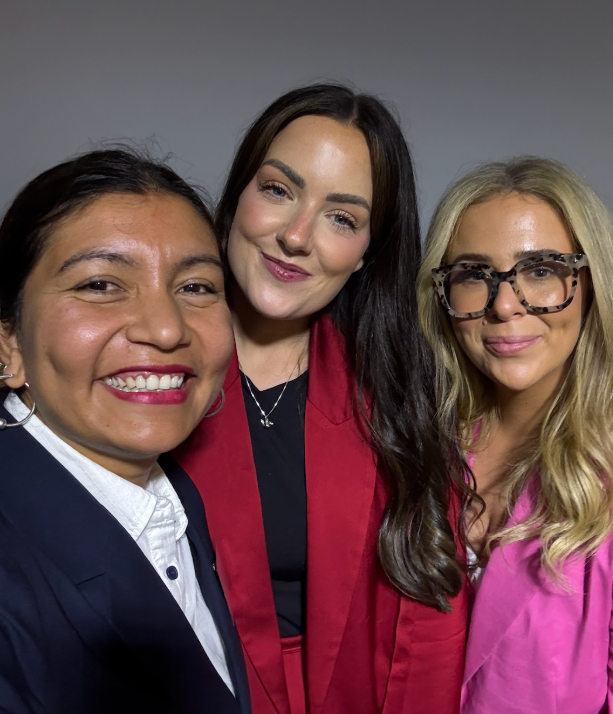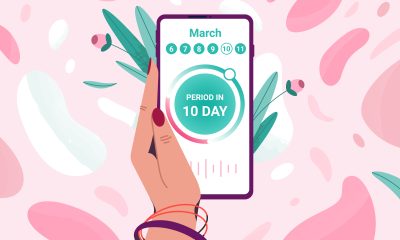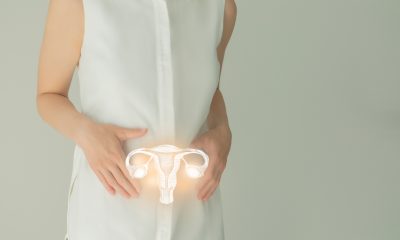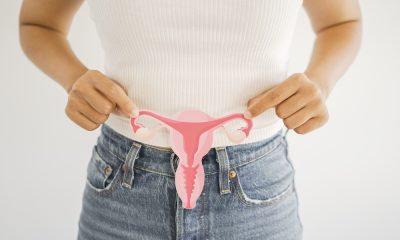Opinion
‘I have never been offered any kind of support’: bridging the gap in healthcare for women with endometriosis
By Carla Cressy, founder and CEO of The Endometriosis Foundation

My personal experiences of a long-awaited diagnosis of endometriosis led to over a decade battling with healthcare professionals to believe the severity of my pain.
Despite being under the care of gynaecology aged 14, presenting with all the common signs of endometriosis, I was continuously told what I was experiencing was “normal”.
Eventually, in 2016, I was diagnosed with stage four endometriosis through a laparotomy (open surgery), which by this time had led to frozen pelvis disease and infertility, following an unnecessary appendectomy, aged just 25.
Eventually, aged 29, I had no other choice than to undergo a total hysterectomy forcing me into surgical menopause. This was following multiple – eight – operations to try fix the irreversible damage caused by endometriosis.
My surgeries included bladder and ureter reconstruction surgery and bowel surgery, leaving me with an ileostomy (stoma) which I was lucky to have reversed eighteen months later. To this very day, I have never been offered any kind of support outside of my family and friends, or so much as an information leaflet about the condition throughout my entire journey.
Like most people living with endometriosis, I had never heard of the condition. Once diagnosed, I was continuously told it was “just a period issue” and to quite simply “just get on with it”.
I knew I had my work cut out when I discovered there was space for a charity. Since founding The Endometriosis Foundation, a charity dedicated to awareness, education and support, I’ve realised that over the years sadly not a lot has changed.
With this in mind, I knew I needed to create a charity that has endometriosis patients’ best interests at heart, a charity I wish existed all those years ago, everything that I never had.
The current state of the healthcare system presents several challenges, particularly in addressing the unique needs of people suffering with endometriosis – a chronic and often debilitating condition affecting millions of people assigned female at birth worldwide.
It occurs when endometrial-like tissue is found growing and functioning elsewhere in the body, leading to inflammation, pain, organ dysfunction, and in some cases organ failure, and infertility.
Despite being common, affecting more than 10 per cent of the female population, a similar number to those affected by asthma and diabetes, it currently takes on average eight years from the onset of symptoms to achieving a diagnosis of endometriosis in the UK. This is despite the condition being listed by NHS England amongst the most painful conditions to have.

Aged 29, I had no other choice than to undergo a total hysterectomy forcing me into surgical menopause
Endometriosis remains significantly underdiagnosed, under-funded, and often misunderstood. This highlights a fundamental issue within the current healthcare system – insufficient awareness, research, funding, and understanding of the condition.
In my opinion, the ideal healthcare system for people with endometriosis would first and foremost address the glaring gaps in the current system.
One of the primary deficiencies is the lack of awareness and understanding about the condition. Currently, many individuals including healthcare professionals, hugely underestimate the severity of endometriosis, which understandably leads to a delay in diagnosis and inadequate treatment. Raising awareness should consequently be a central pillar of the ideal system.
This would involve comprehensive public health campaigns, inclusion of endometriosis education in the school curriculum, and targeted awareness efforts within the medical community. By breaking down the stigma and misinformation surround the condition, we can promote early recognition and understanding, reducing the suffering that many endure.
In addition to awareness, the ideal healthcare system must offer more tailored and multidisciplinary care. Specialised centres staffed with experts in gynaecology, colorectal and urology, and for those who need it, respiratory.
Pain management, holistic therapies such as dietary advice and acupuncture, and fertility services should be established to provide comprehensive care under one roof, tailoring treatment plans to each patient’s unique needs. These centres would streamline the diagnostic process, ensuring that people with endometriosis, of all stages, receive accurate diagnoses promptly.
Furthermore, personalised treatment plans that may involve a combination of medical, surgical, and complementary therapies, accounting for factors like pain levels, fertility wishes, and mental health, should be the norm rather than exception.
Ultimately, I believe mental health services should be integrated into endometriosis care, offering counselling and support to help patients cope with the emotional toll of the condition.
Implementing guidelines for early and accurate diagnosis is essential, and healthcare professionals should be educated on recognising symptoms of endometriosis, and diagnostic tools, such as ultrasound, MRI, and minimally invasive laparoscopic surgery, should be more readily accessible.
By prioritising awareness and comprehensive, patient-centred care, we can create a healthcare system that better supports people suffering with endometriosis.
Carla Cressy is founder and CEO of The Endometriosis Foundation. To support the foundation, go to theendometriosisfoundation.enthuse.com/donate.
News
Women’s health is not niche: It’s the future of healthcare

By Melissa Wallace, CEO & Founding Partner of Fierce Foundry
Just a few years ago, so many conversations around women’s health in the U.S. felt like they were still just making the case for why investment mattered. Panels, white papers, TED-style talks pointed to under-funding, data gaps, structural bias. But something has shifted. Across healthcare and investment communities, the tone now is more about when, not if, and increasingly how.
A compelling indicator of this shift arrived in early August, when the Gates Foundation announced a $2.5 billion commitment to advance women’s health research and development through 2030, fixing its spotlight on long-neglected areas such as menopause, heavy menstrual bleeding and endometriosis. (Reuters) Paired with this, industry commentary emphasises that med-tech devices specifically for women are gaining investor interest at a notable pace. (Medical Device Network)
This sort of capital commitment and investor signal was rare even just a couple of years ago, it underscores a rising belief that women’s health is not just a moral imperative, but a strong market opportunity with measurable returns.
The momentum is palpable here in the U.S.: deficits in research and care persist (for example, women’s health startups captured a record ~$2.6 billion in venture funding in 2024, up from ~$1.7 billion in 2023). (BioPharmadive) And while the sector remains under‐capitalized overall (some reports suggest only ~2% of healthcare investment goes to women’s‐health solutions) (Morgan Lewis) the trajectory is unmistakable.
What’s causing the flip?
- From niche to mainstream: The definition of “women’s health” is expanding in the U.S. It’s no longer just fertility or gynecology, it now encompasses perimenopause, longevity, autoimmune conditions, cardiovascular issues in women. “We’re finally seeing women’s health shift from the under-invested side-line to an innovation category that VCs believe can outperform,” said Raysa Bousleiman, Senior VP for Investor Coverage at Silicon Valley Bank.
- Data gaps turning into data opportunity: For decades, women’s biology, hormonal cycles, mid-life transitions were under-researched. That created both risk and opportunity. Today, tools such as AI, advanced imaging and genomics are closing those gaps. One insightful analysis argued that AI could fundamentally reshape women’s health by tackling “data deserts, bias, and gaps.” (World Economic Forum) Investors increasingly see that the business case is real, not just the moral one. The report “The WHAM Report” frames women’s health investment as “a pathway to societal impact, economic resilience and sustainable growth.”(Wham Now)
- Exit and scale signals: The proof of performance is emerging. In the U.S., scale players are projecting women’s health lines hitting milestone revenues. In Europe, a company raised hundreds of millions targeting ovarian cancer and perimenopause. These “top-of-the-chain” moves may feel distant to early-stage founders, but they shift perception fundamentally: women’s health is not a boutique play, it’s investable, scalable, strategic.
- Shift in investor mindset: No longer is women’s health simply a “good cause”; it’s a growth category. Fund managers are citing track records, asking to raise dedicated funds, deploying dollars not just to be socially responsible but to achieve outsized returns. That shift changes how founders engage, what boards expect, what exits look like.
Still, we must be candid: founders in this space continue to face headwinds. For example, one founder, Valentina Milanova of Daye, shared the frustrating anecdote: “I’ve had investors ask me why our tampons have string on them.” That kind of query signals bias, not just about product design, but about the perceived seriousness of the category. Her pragmatic advice to early-stage founders: consider grant funding, especially in Europe, as founder-friendly capital that can help bridge to private investment.
What does this all mean for U.S. organizations and the broader ecosystem?
For healthcare organizations: The signals are clear. Women’s health is moving from underserved niche to strategic priority. In the U.S., institutions and health systems that double-down here now may gain first-mover advantage, whether by building multidisciplinary women’s health centres, partnering with innovative startups, or harnessing data insights tailored for women. The business case is sharper than ever: women make up 51 % of the population, drive ~80 % of healthcare decisions, and still face care gaps. (Wham Now)
For investors and founders: This is a moment. The conversation is no longer simply “why invest in women’s health” but “how to invest in women’s health at scale”. Founders should be ready to show performance, not just potential. Investors should demand sex-disaggregated data, metrics beyond fertility, and a broader view of women’s life-course care. The heavy lifting remains but it’s now being valued.
For the market at large: The under-served areas are many perimenopause, mid-life wellness, autoimmune conditions in women, hair loss, anorectal care, longevity for women, all of which were once sidelined. That white space, combined with rising capital and broader recognition, fuels a powerful market dynamic.
The story of women’s health is being rewritten. Where once the conversation focused on why, today it increasingly focuses on how. The category is shifting toward performance, scale, credibility. For healthcare organizations willing to commit whether via partnerships, internal innovation or capital deployment, this is not just a mission. It’s a strategic opportunity. And the message is resonating: women’s health is not an afterthought anymore. It’s one of the fastest-growing, most under-leveraged frontiers in healthcare.
Adolescent health
Listening to pain: What eight women taught me about the state of women’s health in the UK

By Ruby Raut, founder & CEO, WUKA
It’s Ruby here, founder of WUKA and, like many of you, someone who’s been dismissed, doubted, and left waiting far too long when it comes to menstrual health.
Last week, I spoke at an event hosted by the Menstrual Health Project. It wasn’t just another panel or pitch session; it was a wake-up call.
The room was filled with GPs, pharmacists, educators, innovators, and women who have lived the daily reality of conditions like endometriosis, PCOS, PMDD, and premature ovarian insufficiency.
We weren’t there to celebrate solutions. We were there to listen. And what we heard broke us open.
The Stories Behind the Statistics
I walked out of that room with one page of notes — not data, not theory, but pain in ink.
The stories were raw and repetitive. Women told us of:
- 14 years of seeking help and getting none.
- 3 decades of living in pain.
- Being laughed at for wanting to come off contraception.
- Being told to “just go on the pill.”
- Waiting for a laparoscopy since 2015, and still waiting in 2025.
- Being asked to gain weight to get a period or lose weight to manage PCOS.
- Being offered pregnancy as a “solution.”
- Losing jobs because of endometriosis.
This is not an isolated list of frustrations. It’s a mirror reflecting the state of women’s health in the UK today.
Behind every statistic, there’s a woman who has rearranged her life around pain, missed promotions, cancelled plans, and lost trust in her own body.

The System Is Failing Us, and We Know It
Hearing these stories, I couldn’t help but think of it like a leaking roof.
You notice the drip, you report it, but you’re told it’s nothing serious, to just wait it out.
Days turn into months, months into years. By the time someone finally takes a proper look, the ceiling has collapsed.
That’s what living with an untreated women’s health condition feels like, small symptoms dismissed until they become impossible to ignore. That’s what our healthcare system is doing to women.
We don’t have a lack of data, we have a lack of listening.
When women describe pain, the system translates it into exaggeration. When they ask for options, they get the same recycled advice: “Go on the pill.”
The medical model still treats menstruation as a niche, not a vital sign.
And that’s why listening matters. Because until we treat lived experience as evidence, we’ll keep designing systems that ignore reality.
Learning from Lived Experience
As founders, practitioners, and advocates, we often talk about innovation, new tech, better diagnostics, smarter apps. But innovation without empathy is just noise.
Listening to eight women share their stories of endometriosis, PCOS, and PMDD reminded me of something fundamental: we can’t fix what we refuse to feel.
It takes courage to speak about periods, pain, infertility, and loss in a room full of professionals.
Yet these women did, not because they wanted sympathy, but because they wanted change.
Their words carried a collective message: “We don’t need to be fixed, we need to be heard.”
The Change We Need
So, what would change actually look like?
- Menstrual health education in medical schools.
Not as a module, but as a mainstream subject. Every GP, nurse, and specialist should understand menstrual health the way they understand blood pressure. - Inclusive menopause and menstrual support, for all ages, all bodies.
Menstrual and menopausal health should not be separate conversations. Hormonal health spans a lifetime. - Accessible care at every level.
Support should start at the local pharmacy, not five years into a diagnosis journey. Pharmacists and primary care teams can be the first line of empathy and intervention. - Private and public health insurance that covers menstrual conditions.
No woman should have to choose between financial stability and pain management. - Policy change that protects and respects women’s health.
We need national recognition that menstrual health is not a luxury — it’s a basic human right.
What Listening Really Means
Listening is not passive. It’s radical.
It means staying in the discomfort of someone else’s pain long enough to see the system that caused it. It means asking, not assuming. It means holding space before we offer solutions.
The Menstrual Health Project event reminded me that we can’t rely on numbers alone. Data gives us proof. Stories give us purpose. And when you combine both, that’s when transformation begins.

Why WUKA Cares
At WUKA, we started with period underwear, but what we’re really building is period equity.
Every conversation, campaign, and product we create is rooted in one belief: women deserve better.
Better care. Better education. Better respect.
Because menstrual health is not a side issue. It’s a social justice issue. It’s about the right to live without shame, without silence, and without suffering that’s dismissed as “normal.”
If you’re someone living with any of this, endometriosis, PCOS, PMDD, or anything that makes you feel unseen, I see you. You are not alone. You deserve better, and we will keep fighting for you.
Let’s listen louder. Let’s care deeper. Let’s make menstrual health mainstream.
With you always,
Ruby x
Founder & CEO, WUKA
P.S. Check out the incredible work of the Menstrual Health Project. They’re not just raising awareness, they’re rebuilding the narrative.
Opinion
Why gestational diabetes underdiagnosis is a women’s health crisis

By James Jackson, CEO at Digostics
Gestational diabetes (GDM) is one of the most under-recognised challenges in maternity care today.
Despite affecting around one in five pregnancies in the UK, GDM remains a blind spot in policy and practice, with devastating consequences for women and their children.
New research continues to expose the scale of the problem.
A recent NIHR-funded study published in Diabetic Medicine found that standard NHS testing methods miss over 50 per cent of cases.
Put simply: thousands of women each year go undiagnosed, untreated, and exposed to avoidable risks.
For a condition we know how to diagnose and manage, this represents a serious failure in women’s healthcare.
The human cost of missed diagnosis
When gestational diabetes is not picked up, the consequences are immediate and long-term.
During pregnancy, women face higher risks of preeclampsia, larger babies, emergency C-sections, and stillbirth. Babies are more likely to need neonatal intensive care due to breathing difficulties or low blood sugar.
The risks don’t end at birth.
Mothers who have had GDM are up to 50 per cent more likely to develop type 2 diabetes within 5–10 years. Their children also face an increased lifetime risk of obesity and diabetes.
These outcomes are not rare, nor are they inevitable. They are the product of a testing system that is not fit for purpose.
An unequal system
Current UK pathways rely on risk-factor–based screening rather than universal testing.

James Jackson
This already puts women at a disadvantage compared with countries such as Spain, Italy, and many others, where all pregnant women are routinely screened.
But even within this narrower approach, the NHS faces a further problem: in-clinic oral glucose tolerance tests (OGTTs), used to test for GDM, are prone to delays in blood sample processing, leading to false negatives.
Research shows that when samples are processed correctly diagnoses increase from 9 per cent to 22 per cent — more than double.
The burden of this diagnostic failure falls hardest on women from disadvantaged backgrounds.
Attending early-morning, hospital-based tests is more difficult for women juggling shift work, childcare, or long travel times.
Women from ethnic minority groups, who already face higher rates of maternal complications, are also more likely to be missed. In this way, testing failures are not just a clinical problem but a driver of health inequalities.
The case for innovation
This is where innovation can play a transformative role.
We have seen in other areas of healthcare — from remote monitoring to home blood pressure checks — how new approaches can increase accuracy, improve access, and reduce inequalities.
Gestational diabetes testing should be no different. Technologies such as at-home oral glucose tolerance tests (OGTTs) are designed to meet the same clinical standards as hospital testing, while overcoming the practical barriers of travel, fasting, and sample degradation.
By enabling women to test from home, results can be processed immediately and shared directly with care teams, reducing missed cases and ensuring timely diagnosis.
Early work with NHS Trusts has already shown that this model not only identifies more cases but also improves access for diverse patient groups, including those typically underserved.
From evidence to action
Despite clear data, progress has been slow. Part of the challenge is that more accurate testing uncovers more cases — and more cases mean more workload for already stretched maternity services.
But failing to diagnose does not make the problem go away; it only delays care and worsens outcomes.
In the long run, undiagnosed gestational diabetes costs the NHS more through emergency interventions, neonatal intensive care, later-life type 2 diabetes, and the ongoing workload and cost pressures this creates for primary care.
The evidence is clear. Now it must translate into policy. That means:
- Recognising underdiagnosis as a patient safety issue on par with other maternity scandals.
- Guaranteeing that all women offered testing receive accurate, reliable results, rather than being failed by flawed processes.
- Supporting innovation that improves accuracy and equity, whether in the clinic or at home.
- Embedding the patient voice in service design, especially from women in disadvantaged and minority communities most affected by current failures.
A call to prioritise women’s health
Gestational diabetes is not a niche concern; it is a mainstream women’s health issue with lifelong consequences.
Every undiagnosed case represents not just a missed number, but a mother at risk of preeclampsia or birth trauma, a baby at risk of intensive care, or a family facing preventable illness later in life.
As maternity services undergo yet another review, it is striking that the diagnostic gap in GDM remains so little discussed.
We cannot claim to be serious about women’s health while ignoring one of the most widespread and preventable sources of harm in pregnancy.
Innovation has a role to play — but innovation must be matched by policy will.
If we are to modernise maternity care, we must start by ensuring that every woman has access to accurate, timely, and equitable testing for gestational diabetes.
Because every mother deserves certainty. And every baby deserves the best start in life.

 News4 days ago
News4 days agoDozens of women report suffering painful burns after using Always sanitary towels

 Opinion3 weeks ago
Opinion3 weeks agoFDA plans to revise black box warning on menopause hormone therapies

 Entrepreneur2 weeks ago
Entrepreneur2 weeks agoAI-powered women’s health companion Nexus launches in UK

 Insight1 week ago
Insight1 week agoWomen’s health innovations recognised in TIME’s Best Inventions 2025

 News3 weeks ago
News3 weeks agoScientists turn human skin cells into eggs in IVF breakthrough

 Wellness3 weeks ago
Wellness3 weeks agoDaily pill could delay menopause ‘by years,’ study finds

 News3 weeks ago
News3 weeks agoAncient herb to modern must-have: Why ashwagandha is capturing UK women’s attention

 News2 weeks ago
News2 weeks agoMenstrual cycle affects women’s reaction time, study finds




























